AIR SPOTLIGHT: INDIA'S DIGITAL ECONOMY
Context: India's digital economy is expected to witness exponential growth to $800 billion by 2030 on the back of rising internet penetration and increasing income, Finance Minister Nirmala Sitharaman said.
More on the news:
- Finance Minister said India has over 6,300 fintechs, of which 28% are into investment technology, 27% into payments, 16% into lending and 9% into banking infrastructure, while over 20% are into other fields.
- Combined valuation of India's fintech industry is set to surge to $150 billion in next three years.
- The finance minister said that majority of the startup unicorns are from fintech sector and that the easy availability of funding has helped them grow.
- Government has made it easier in terms of smooth and easy access to the stock markets, with technology such as e-KYC and e-Aadhaar helping the retail investors come into the market.
- The total number of retail investor accounts has almost doubled, from about 45 million as of March 2016 to 88.2 million by March 31 2021.
- 10 per cent rise in internet penetration results in an increase of 3.9% in GDP per capita.
- Recent Budget has announced setting up of 75 Digital Banking Units (DBUs).
- With regard to Unified Payments Interface (UPI), 4.5 billion transactions entailing transfers of more than ₹8.2 trillion have taken place in February.
What is Digital Economy?
- It refers to an economy that is based on digital technologies.
- The digital economy is also sometimes called the Internet Economy or Web Economy. The digital economy became the model global economy as the last stage for the devolvement of the economy and it considers as a result of using the information technology in different economic fields, such as what happened in all our life activities.
- According to Mesenbourg, three main components of the ‘Digital Economy’ concept can be identified:
- Supporting infrastructure (hardware, software, telecoms, networks, etc.
- e-business (how business is conducted, any process that an organization conducts over computer networks)
- E-commerce (transfer of goods). But new applications are blurring these boundaries and adding complexity – for example, social media and Internet search.
Importance:
- The growth, integration and sophistication of information technology and communications is changing our society and economy.
- In this digital economy, consumers are becoming more powerful and companies find themselves with new avenues for building competitive advantage. Mobile devices, social networking, cloud computing, grid computing and other technologies are profoundly transforming the relationships between businesses and their customers.
- Digital technology in the form of the Personal Computer and the Internet has already transformed work, education, government, entertainment, generating new market opportunities and having a major economic impact across a broad range of sectors.
- Digital networking and communication infrastructures provide a global platform over which people and organizations devise and employ new business strategies, interact, communicate, collaborate and seek information regardless of time and location.
Significant Achievements by India in this field:
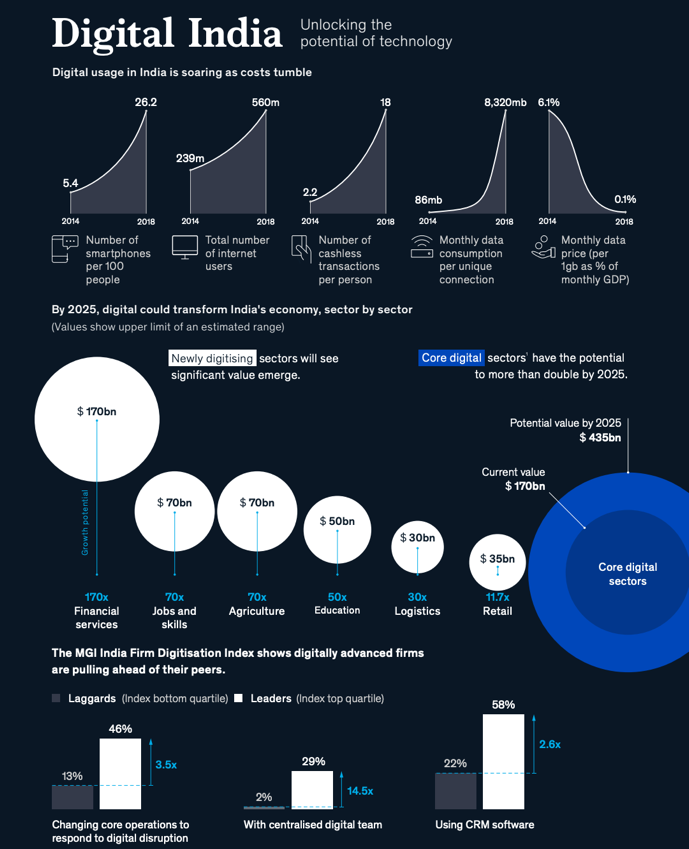
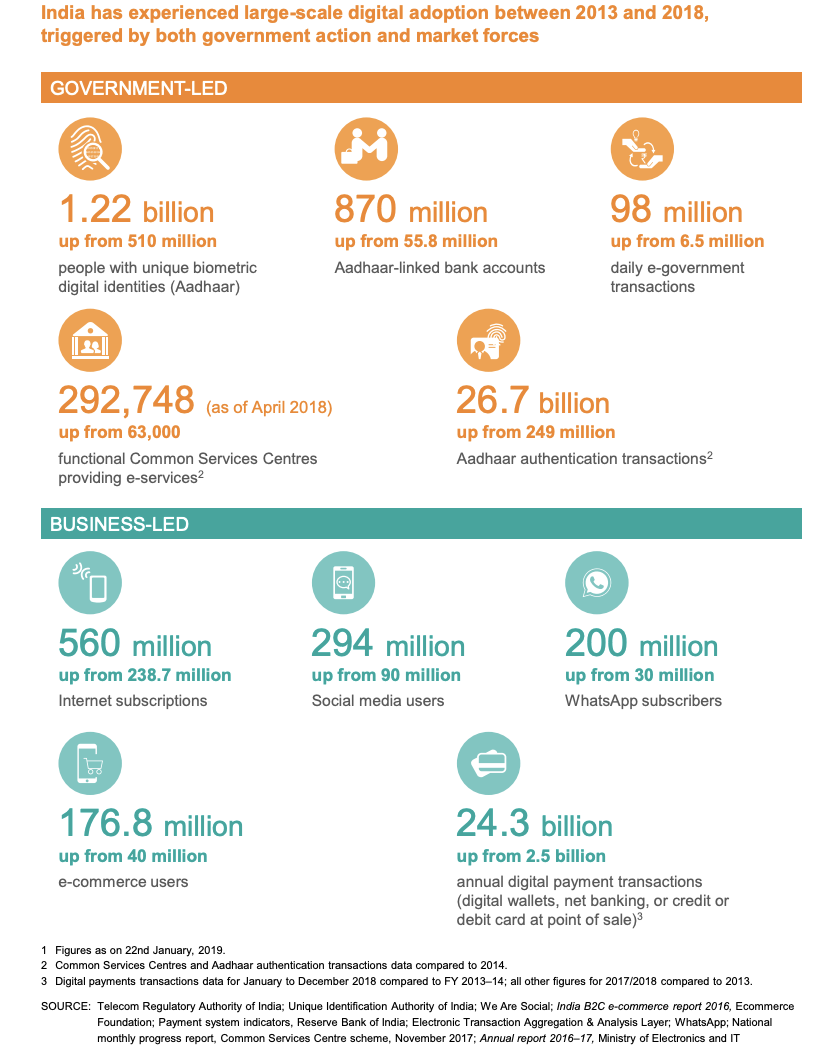
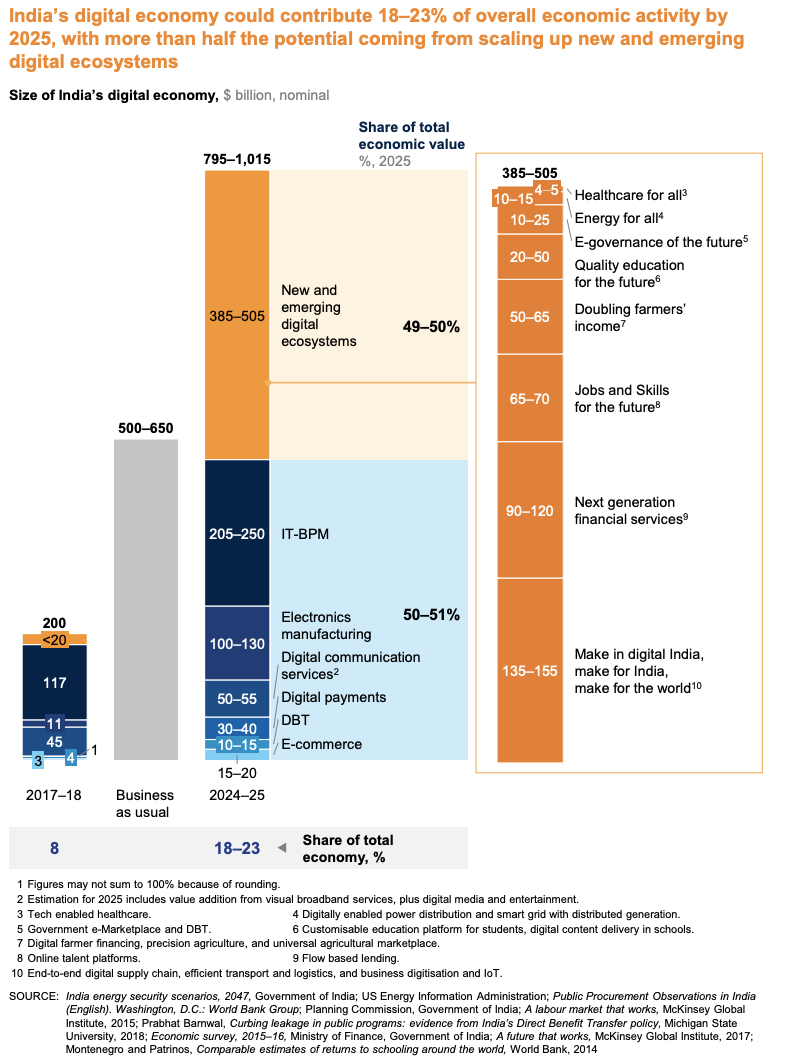
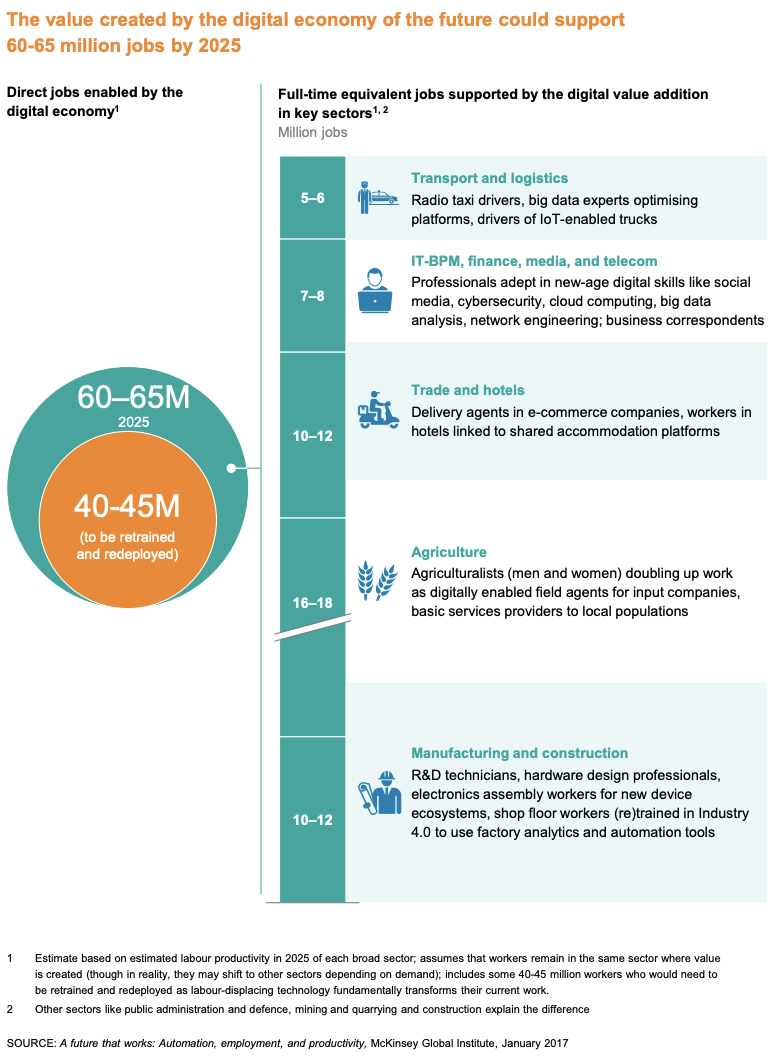
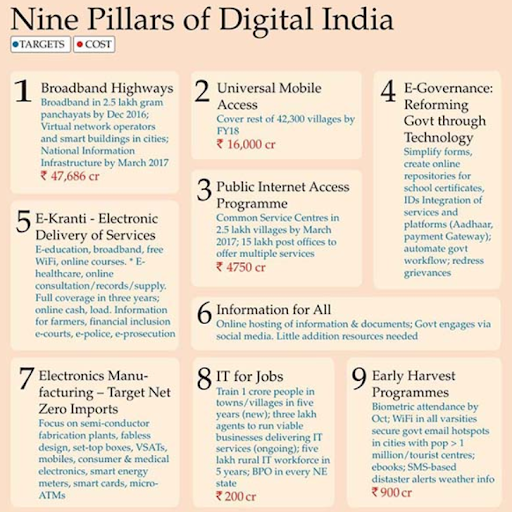
- India is among the top three global economies in number of digital consumers. With 560 million internet subscriptions in 2018, up from 238.71 million in 2013, India is the second-largest internet subscriptions market in the world. 4 Likewise, India has the second-largest number of instant messaging service users worldwide, behind China, and the most social media users.
- Aadhaar, India’s unique digital identity programme, covers more than 1.2 billion people, the largest system of its type globally.
- India’s digital index score has moved from 17 in 2014 to 32 in 2017 (on a scale of 0 to 100), second-fastest rise after Indonesia. India has performed well on e-governance and digital identity, the rate of growth of mobile internet access, and the uptake of digital media by online consumers.
- India’s digital divide is narrowing fast as less affluent states leapfrog to catch up with more affluent states. Between 2014 and 2018, of the 10 states with highest rate of growth in internet subscriptions, seven had per capita GDP lower than India's average.
SWOT Analysis of India in this field:
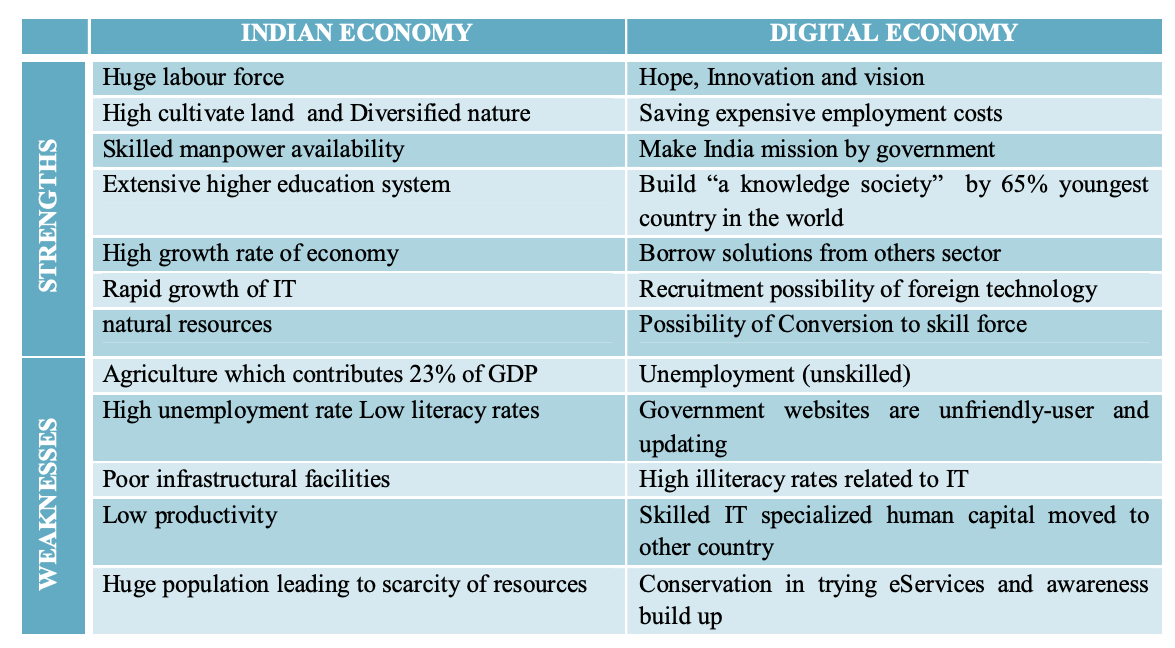
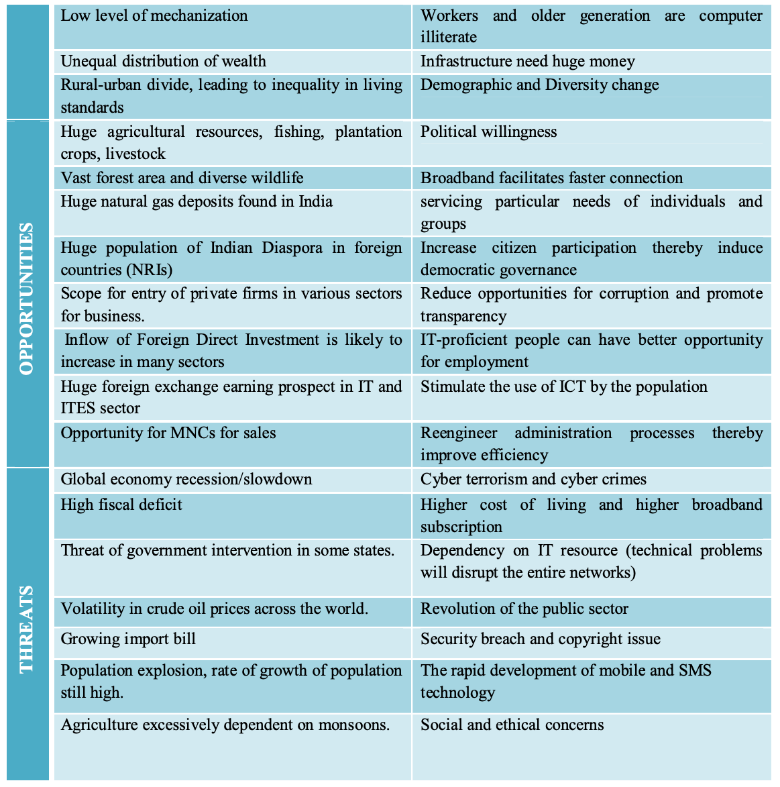
Way Forward:
- Thirty digital themes, if scaled up nationally, can accelerate India’s progress in nine key areas and help create up to $1 trillion of economic value in 2025.
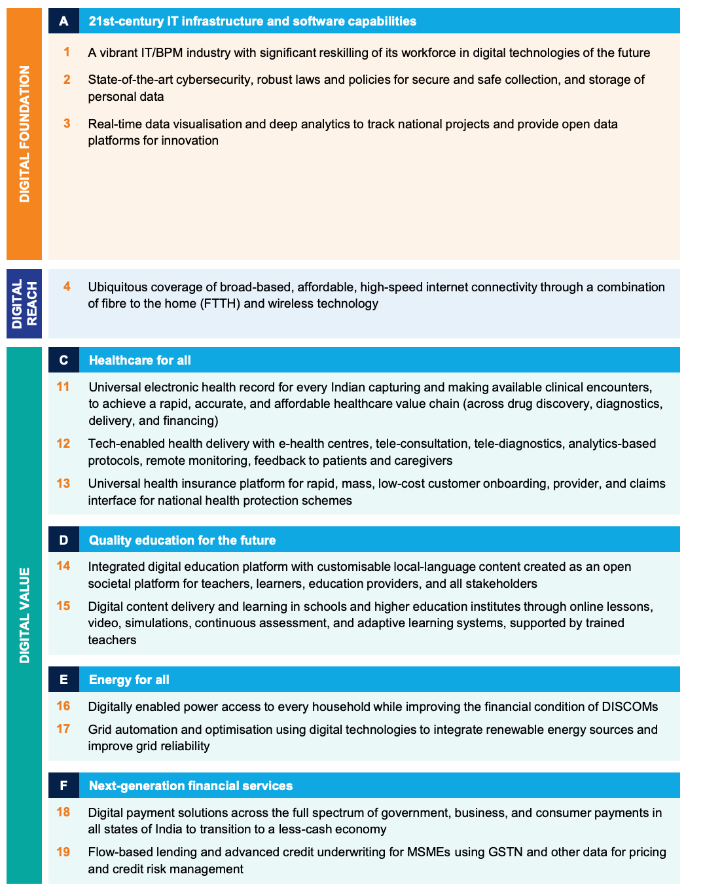
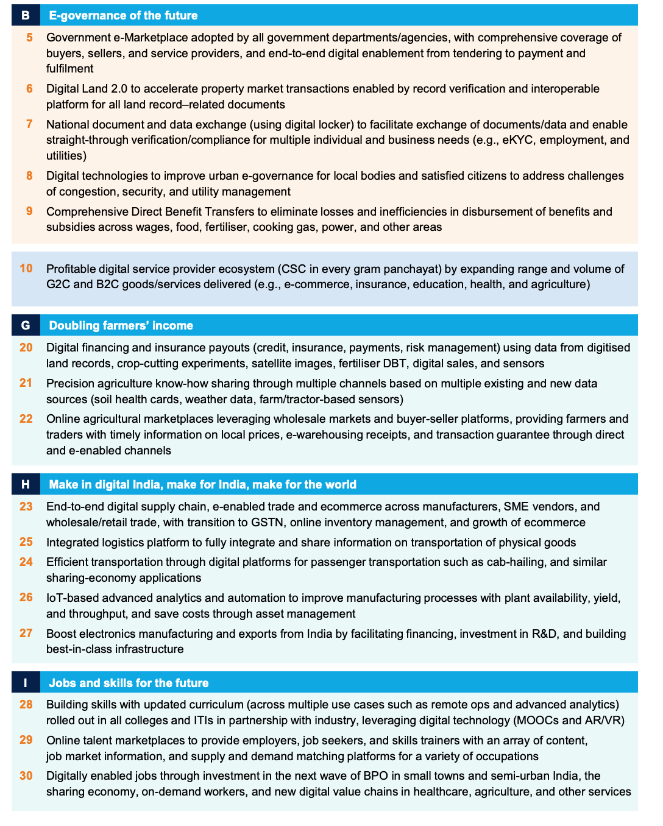
https://www.livemint.com/economy/indias-digital-economy-to-see-exponential-growth-to-800-bn-by-2030-fm-11647014673827.html
https://www.researchgate.net/publication/325036210_Digital_Economy_in_Indian_Context/link/5af2b008aca272bf4259e458/download
https://www.mckinsey.com/~/media/mckinsey/business%20functions/mckinsey%20digital/our%20insights/digital%20india%20technology%20to%20transform%20a%20connected%20nation/mgi-digital-india-in-brief-april-2019.pdf
https://www.meity.gov.in/writereaddata/files/india_trillion-dollar_digital_opportunity.pdf
NEWS IN BRIEF: PRELIMS SPECIAL
Draft National Medical Devices Policy 2022
- The Department of Pharmaceuticals, under the Ministry of Chemicals and Fertilizers has released the Draft National Policy for the Medical Devices, 2022 on its website for consultation.
- The Ministry of Chemicals and Fertilizers said that the Draft policy aims at addressing the core objectives of accessibility, affordability, safety and quality, focus on self-sustainability, innovation and growth in the Medical devices sector.
- Regulatory streamlining to optimize regulatory processes and to promote ease of doing business.
- Quality Standards and Safety of the Devices in order to provide safe devices to the consumers.
- Infrastructure Development to provide the best physical foundation, including medical devices parks with common facilities such as testing centers, to improve cost competitiveness and enhance attraction of domestic manufacturers.
- Promoting Research and Development and Innovation.
- Human Resource Development to create manpower with required skills.
- Awareness Creation and Brand Positioning in creating awareness and positioning India as a hub for manufacturing of medical devices as part of the “Make in India, Make for the World” initiative.
- This Policy target that by 2047, our Country
- Will be home and originator to 25 high-end futuristic technologies in MedTech.
- Will have a MedTech Industry of $100-300 Bn size with 10-12% of Global Market Share.
https://newsonair.gov.in/News?title=Department-of-Pharmaceuticals-releases-Approach-paper-on-%26%2339%3BDraft-National-Medical-Devices-Policy-2022%26%2339%3B-for-consultation&id=437067
Maternal Mortality Rate
- Kerala tops in maternal and child health, recording the lowest Maternal Mortality Ratio (MMR) of 30 (per one lakh live births) in the country. Kerala is way ahead of the national MMR of 103.
- According to the latest Sample Registration System (SRS) special bulletin on maternal mortality in India (2017-19), released by the office of the Registrar General of India, Kerala’s MMR has dropped by 12 points.
- According to the date, Kerala has achieved the target based on the U.N. Sustainable Development Goals, of an MMR of 30 by 2020.
- Maternal mortality is the maternal death of a woman during pregnancy or after pregnancy, including post-abortion or post-birth periods.
- India contributes one-fifth of the global burden of absolute maternal deaths.
- 94% of all maternal deaths occur in low and lower middle-income countries.
- India’s present MMR is below the Millennium Development Goal (MDG) target and puts the country on track to achieve the Sustainable Development Goal (SDG) target of an MMR below 70 by 2030.
https://newsonair.com/2022/03/15/indias-maternal-mortality-ratio-witnesses-a-remarkable-drop-by-10-points/
Microfinance Institutions
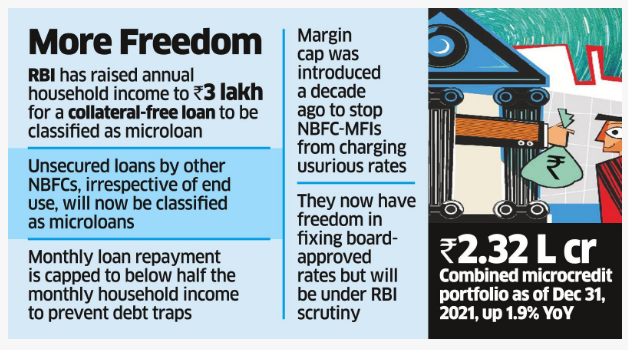
- Microfinance institutions (MFIs) are financial companies that provide small loans to people who do not have any access to banking facilities.
- In India, a microfinance loan is defined as a collateral-free loan given to a household having an annual income of up to Rs 3 lakh. (Recently revised by RBI. Earlier it was Rs 1 Lakh)
- Example of MFIs: Bandhan Bank Limited, Ujjivan Small Finance Bank, Annapurna Finance Pvt. Ltd, Muthoot Microfin Limited, CreditAccess Grameen Limited, Sonata Finance Private Limited etc.
https://newsonair.com/2022/03/16/rbi-removes-interest-cap-for-microfinance-loans/
OROP
- The Supreme Court ruled there was “no constitutional condition” in the way the government had introduced ‘one rank, one pension’ (OROP) among ex-service personnel.
- The scheme, notified by the Defense Ministry in 2015, was challenged by Indian Ex-Service Movement, an association of retired defense personnel.
- The Supreme Court said that there “is not a legal mandate that pensioners who hold the same rank must be given the same amount of pension”.
- One Rank One Pension (OROP), or "same pension, for same rank, for same length of service, irrespective of the date of retirement".
https://newsonair.gov.in/News?title=Supreme-Court-upholds-Government%E2%80%99s-
decision-on-One-Rank-One-Pension-for-defence-forces&id=437280
E-tourist Visa
- India restores e-tourist visa for 156 countries.
- It enables the prospective visitor to apply for an Indian Visa from his/her home country online without visiting the Indian Mission and also pay the visa fee online.
- e-Visa has been sub-divided into 5 categories i.e.
- e-tourist visa
- e-Business visa
- e-Medical visa
- e-Conference and
- e-Medical Attendant.
- On e-Tourist Visa continuous stay during each visit shall not exceed 90 days in case of nationals of all countries who are eligible for grant of e-visa except nationals of USA, UK, Canada and Japan.
- On e-Business visa continuous stay during each visit shall not exceed 180 days in case of nationals of all countries who are eligible for grant of e-visa.
- The facility will encourage people to travel with short-term planning, take via routes while travelling to other countries and bring family members while on business visits.
https://newsonair.gov.in/News?title=India-restores-e-tourist-visas-that-remained-suspended-since-March-2020&id=437346
Hijab verdict
- A full bench of the Karnataka High Court stated that the wearing of the hijab by Muslim women does not make up an essential religious practice in Islamic faith.
- The High court mentioned that the prescription of a school uniform is a reasonable restriction on the Right to freedom of Religion under Article 25 of Indian Constitution.
- The ‘essential practice’ doctrine can be traced to a 1954 decision of the Supreme Court in ‘Shire Mutt’ case. In this Case the Court said: “In the first place, what constitutes the essential part of a religion is primarily to be decided with reference to the doctrines of that religion itself.”
https://newsonair.gov.in/News?title=Karnataka-HC-says%2C-Hijab-is-not-an-essential-religious-practice-of-Islam%2C-dismisses-various-petitions&id=437205













